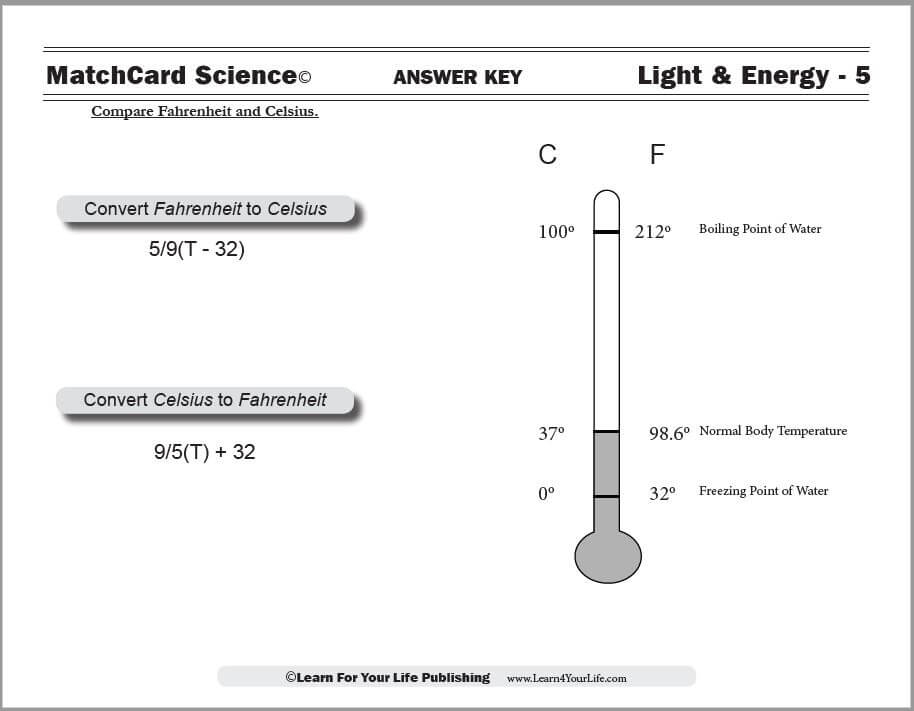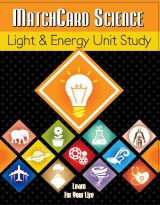The Celsius to Fahrenheit Worksheet
The Celsius to Fahrenheit worksheet from MatchCard Science investigates the freezing and boiling points of different substances; and practices converting between the two scales.
Free Download Below


Print the Celsius to Fahrenheit Worksheet


This is MatchCard #5 of the Light and Energy Unit Study. Find more information on MatchCard Science below.
Celsius and Farhenheit
Objective: Compare celsius and fahrenheit.A simple starting point in comparing celsius and fahrenheit scales is to have the student take their temperature. If you have a thermometer that registers in both celsius and fahrenheit, check both.
Explain that the average temperature for humans is 98.6 F or 37.0 C.
To gain practice using both, check daily climate temperatures in both fahrenheit and celsius scales. Have them estimate the temperatures before checking them.
Boiling Point of Water
Here is an experiment to check the boiling point of water. It works best if you have a thermometer that measures both. You could also use two seperate thermometers.- Fill a pan 3/4 full of water.
- Put the thermometer(s) in the water.
- Turn the stove top on.
- Observe the temperature as it rises on the thermometer.
- Note the boiling point of water.
Compare that with the fact that the human body temperature is 98.6 degrees F. Consider how confusing it would be if you mixed up the two scales.
Freezing Point of Water
It's a little trickier to test the freezing point of water. Here is how to do it:- Fill a tall container 3/4 full of water.
- Put the tall container with water in a wider container, like a mixing bowl.
- Put ice in the mixing bowl around the container of water.
- Cover the ice with salt.
- Stand the thermometer upright in the ice/salt mixture.
- Put the bowls in the freezer.
- Check the temperature every ten minutes.
Let's Think About It
Which scale is easier to use?- Celsius - which has a boiling point of 100 degrees for water and freezing point of 0 for water?
- Fahrenheit - which is what we are more used to when talking about weather temperatures?
Take It Further
Explain that every substance has its own boiling point and freezing point. Those points are different for different substances. You may want to repeat the experiment and use other household liquids.- Juice (which is water plus other liquid)
- salt water
- milk
- rubbing alchol
- vinegar
A Tasty Twist
You will likely get no complaints if you take your freezer experiments a bit further and make homemade ice cream. The directions are also on the Celsius to Fahrenheit Marchcard.- Add the following ingredients to a sandwich size resealable freezer bag:
- 1/4 cup of sugar
- 1/2 cup of milk
- 1/2 cup of whipping cream
- 1/2 teaspoon vanilla extract
- Seal the bag tightly.
- Add the following to a large freezer resealable bag and mix well:
- 2 cups of ice
- 1 cup of salt
- Put the small bag into the large bag. Seal tightly.
- Wrap a towel around the large bag to prevent frost bite. Rock the mixture back and forth.
You might want to save a little of the final mixture to experiment on the boiling point of ice cream. But don't be surprised if there is nothing left.
Learning More
The Condensation MatchCard (Light and Energy-6) will take some of the temperature concepts from the Celsius to Fahrenheit Worksheet here even further.Also, use the mathematical formulas to convert back and forth between the celsius and fahrenheit scales. Older students (7th grade and above) should know this formula. Younger students should be aware that it is available for use.
- 5/9(T - 32) Converts fahrenheit to celsius
- 9/5(T) + 32 Converts celsius to fahrenheit
MatchCard Science
How To Use MatchCards

Download the FREE MatchCard Science Instructor's Guide and see how MatchCards can make building their science knowledge base fun.
Light and Energy Unit Study

Download the entire Light and Energy unit study.
12 Science Unit Studies

Chemistry is only one of twelve complete unit studies for kids in 3rd to 8th grade.
Comprehensive objectives, hands-on projects, suggested science fair experiments, and the fun game-like MatchCards keep them interested in learning science. See all twelve MatchCard Science Unit Studies.
About Our Site
Hands-On Learning













